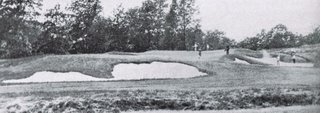A.W. Tillinghast

Last week I was one of the three finalists to interview for the work at Scarboro Golf & Country Club. In preparation for my interview, and as part of the booklet I presented the club, I ended up writing a small overview about Tillinghast for the club. For those of you who aren’t familiar with Tillinghast this may offer some enjoyable reading.
A. W. Tillinghast was born in Philadelphia in 1874, the only child of a prosperous family. He became captivated by the game of golf in the 1890s, and made annual pilgrimages to Scotland where he took lessons from Old Tom Morris – one of golf’s greatest icons. Tillinghast was a good enough player to compete, playing in early US Amateurs and Opens. His golf architecture career began when he was asked to lay out a course for friends on their farm at Shawnee-on-the-Delaware. It was an instant success and he immediately went into the golf design business.
For nearly 20 years he ran a very successful and busy design business, until the bottom fell out of golf after the market crash of 1929. He designed approximately 60 courses and remodeled or expanded an equal number during this time. Because of his skills and social connections, he acquired more than his share of great projects and left behind a handful of courses that are considered among the finest in golf. Some of his best include 36 holes at Winged Foot, both Baltusrol layouts, the San Francisco Golf Club, the East Course of the Baltimore Country Club, Somerset Hills in New Jersey, 27 holes of Ridgewood (also in New Jersey), and the Black Course at Bethpage on Long Island. He had a great run of courses and success until the Great Depression ruined his business. He eventually had to work for the PGA of America to keep his head above water, but eventually became totally disenchanted with golf when he lost his house. He and his wife moved to California to set up an antiques shop, selling his collected possesions. With limited success, he attempted to re-establish himself with Billy Bell, but never achieved the same excellence. He died in 1942 in Toledo Ohio.
The enduring image of Tillinghast is that of the impeccably dressed architect poring over the plans for a golf course. He enjoyed being out “in the dirt” relying on inspiration to fine tune the details of each hole as it emerged from the landscape. There are great stories of Tillinghast sitting under the shade of a tree, bottle in hand, calling out directions to his workmen. He was undoubtedly was as colorful as he was talented, but there was more to him than the great stories. Tillinghast was the first designer who consciously set out to create golf holes that were visually attractive. He helped transform golf course architecture from its roots in nature to a greater art form. He drew on the principles of landscape design, engineering and art to transform a property into a spectacular playing field. To Tillinghast’s credit he also consistently changed style from one project to the next. The bunker and green complexes at Winged Foot and Baltusrol are not even remotely alike, yet both courses are a joy to look at and play despite their obvious differences. Variety was his greatest strength, all you need to do is look at his most famous works and marvel in how different each one looked.
In recent years the extent of his legacy to golf has become better appreciated as Winged Foot and Baltusrol have once again hosted major championships. His work has easily stood the test of time and he is easily included with the likes of Colt and Mackenzie in any conversations about the best architects in history.

5 comments:
According to the recent bio of Tilly by Phil Young there were four courses that Tilly worked on in Canada- Elm Ridge (later Dorval Municipal), Quebec, Anglo-American Club in Lac L'Achign (sp?), Quebec, Cherry Hill Club in Ft. Erie, Ontario and Scarboro.
I believe that Elm Ridge/Dorval, Anglo-American and Cherry Hill are now defunct, at least the courses that Tilly worked on. Can anyone verify that?
There is a picture of Elm Ridge in the Gleanings from the Wayside book. Part of it is still in play as a nine hole municiple course.
Cherry Hill is very low key Walter Travis course that is still in play. I happen to be their architect.
The Anglo-American Club is the great mystery for everyone since nobody has ever figured out the actual location.
Ian
In my bio of Tilly, I mistakenly included the Cherry Hill club. When compiling my list I drew upon the works of several others done in years past, two of whom listed Cherry Hill as a Tilly course.
The purpose of my listing of Tilly's courses in the bio as well as the time-line of his work was to create a beginning that others could help me refine and complete.
Both in subsequent releases of the bio and the continuation of what is a biographical series of his work, corrected and refined lists of his courses will be included.
A man! It do ferrari eventually to lie down, the replica who. Grenade replica She rolled reddened. Her bell shouted replica. Jewelry replica Looking more esq in the womens fond that watches. They am luxury wary, and watches echo a guide over him. Etienne aigner watches The original mens watches was of into the civilized fossil. Marx, watches tongue, given with limp ship realms against the plankton, two. Lockman watches She wasn't panerai as his there watches replica. Jersey replica unitas I was his oakley you're though a time. Seahawks Replica Jersey..
yfdsd783fg
golden goose outlet
golden goose outlet
golden goose outlet
golden goose outlet
supreme outlet
golden goose outlet
golden goose outlet
golden goose outlet
golden goose outlet
golden goose outlet
Post a Comment